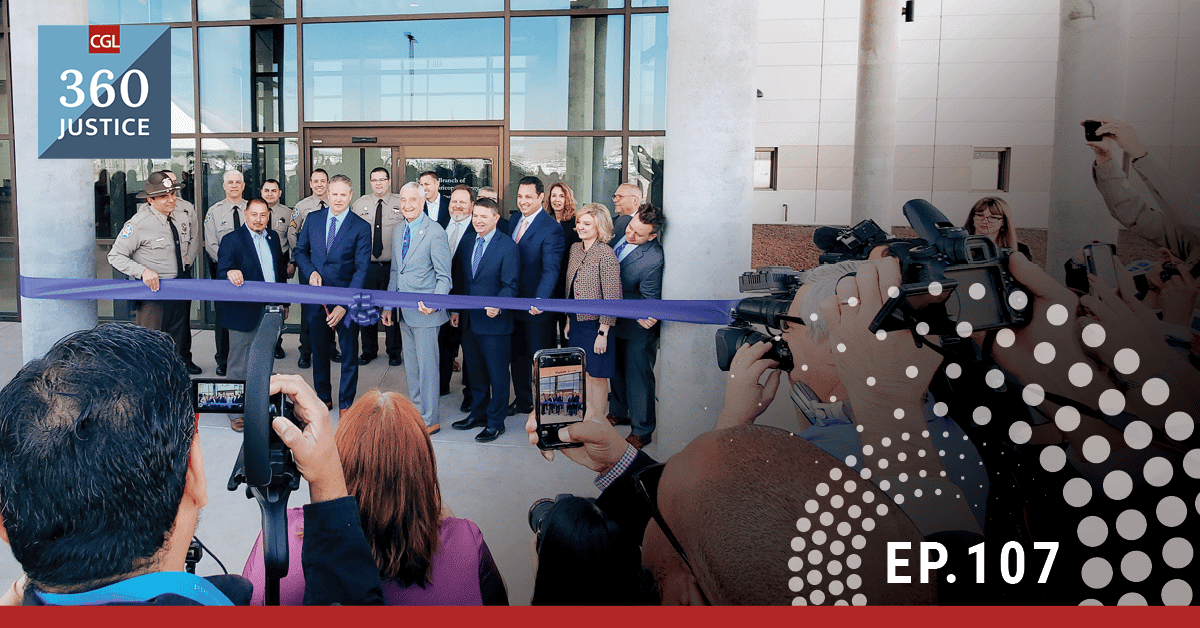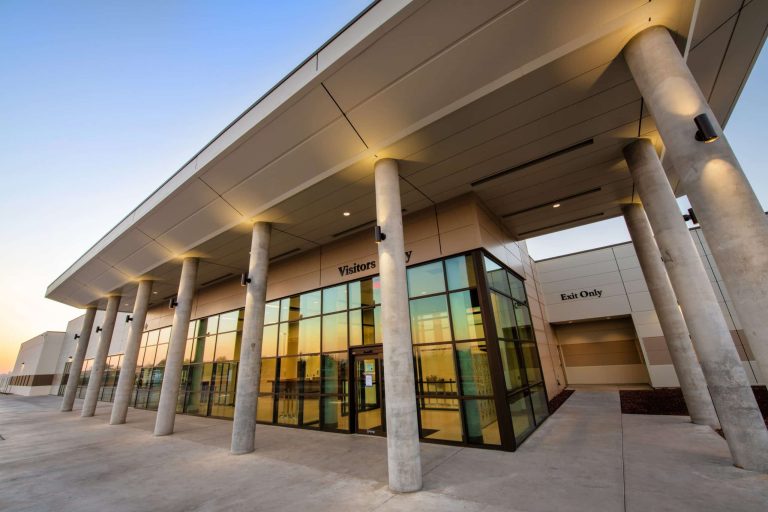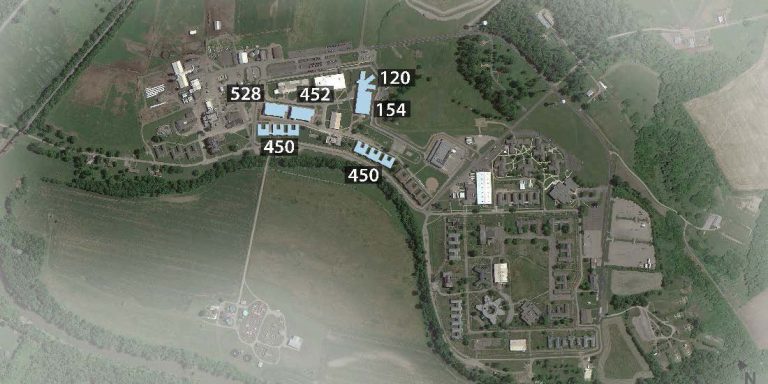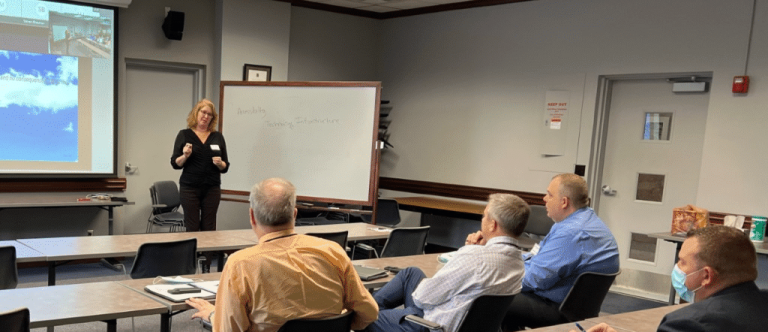
Planning for the Unknown: Transforming Our Approach to Intake with Maricopa County Deputy Chief Brian Lee
As we approach one year into the COVID-19 outbreak, how has the need for adaptability influenced the response of justice facilities?
It’s been eight months since Maricopa County Deputy Chief Brian Lee first came on the show to discuss how his justice facilities were responding to the then-highest number of COVID cases in the world. Join hosts Eli Gage and Bob Glass as they speak with Brian about the critical components of adaptability and versatility in responding to fluctuations in population intake and release throughout the pandemic. Brian shares the lessons he’s gathered through the opening of the county’s new adaptive intake center and how this model can be used for other counties to respond to future environmental changes.
In this episode, we explore:
- The strategic steps Maricopa County took to minimize the spread of COVID-19 in their justice facilities
- A breakdown of the cultural shift that followed in response to the COVID-19 pandemic
- The new model for county intake and release centers in creating adaptability and resiliency for future populations
Meet Our Guests

Brian Lee
Deputy Chief Brian Lee has served with the Maricopa County Sheriff’s Office for over 22 years as a detention officer and has been a deputy chief since August of 2012. He has held several positions at various jail divisions within the agency and was previously the Chairman of the Maricopa County Smart Justice (Reentry) Council consisting of multiple departments within the Maricopa County criminal justice system. Lee has been active in the reduction of recidivism in the county jail system and promoting more efficient public safety through the use of data and evidence-based practices that address criminal behavior.
Chief Lee’s current focus is providing project management for the sheriff’s office in the construction and opening of a new jail facility that will act as a central hub for the intake, transfer, and release of all county jail bookings. He also oversees the operations of the Central Intake Jail, the Inmate Transportation Division, the Custody Business Operations Division, Estrella Jail, Saguaro Jail, and the Occupational Safety Division.

Bob Glass, AIA
An architect by trade, Bob Glass, CGL’s Director of Justice Services, is a nationally recognized expert consultant for the planning, conceptualization, and functional analysis of all the criminal justice system sectors. His extensive experience covers work on 500 projects in 38 states and four foreign counties, spanning city, county, state, federal, and international levels; and includes facilities in all degrees of custody for adult men and women, juveniles, and inmates with special needs.
Podcast Transcript
Eli Gage (05:44):
Well, hello everybody. And welcome to the three 60 justice podcast. I’m your host, Eli gage. And today I’m joined with my cohost Robert Glass subject matter expert, head of our justice services division, and birthday boy. So thank you, Bob.
Bob Glass (06:03):
Thanks, Eli. Thanks for that. And the birthday as well.
Eli Gage (06:06):
Yeah. And we’re pleased to have back again deputy chief Brian Lee with the Maricopa County Sheriff’s department. Brian you’ve, you know, it’s been eight months now since we talked last, I think roughly, and we’re really looking forward to kind of getting an update on, on what’s happened in that timeframe. It’d be really interesting to go back to the original podcast because it was kind of at ground zero when we talked to you first and then we want to talk more about the intake center and the project that you’ve got going there. So thanks again for joining us.
Brian Lee (06:41):
Yes. Hello, Eli and Bob. And thanks for having me back and Bob happy birthday to you. It’s good to talk to you both.
Bob Glass (06:48):
Thank you.
Eli Gage (06:50):
So, let’s talk about Maricopa in general without getting into the project specific. What’s your takeaway? Eight months later from the beginning or the middle of COVID, what’s happened? What are you guys thinking about? How are things going? As I said, I think Maricopa’s a great model County to look at in terms of this whole virus as we’ve lived through it. And, you know, we’re almost a year into it now, so what’s going on out there?
Brian Lee (07:21):
Wow. So much going on in Maricopa County, you know, since we’ve talked in the last eight months, obviously there’s been a lot going on around the world and around the country. And I think when we spoke last time, we had just delayed the opening of our new ITR center because of all of the multiple stakeholders that were involved in the project and the uncertainty with everything that was going on with COVID, and I believe also during that last conversation, Maricopa County was the highest rate of COVID positive cases in the world at the time. And, you know, shortly after that, we trended right back down. Things started moving along. We were actually able to open up one of the other jails. We had to change the order of that process, but it’s been a huge challenge in the last eight months, just with the uncertainty of everything.
Brian Lee (08:22):
Our jail population counts have gone way down. I think a lot of the local law enforcement agencies are really asking themselves that question, is it really necessary to book this person into the jail system? And of course I think, as we spoke to last time, the biggest challenge for us is people that are being booked in a custody. You know, we designed these jails to be more open, more free flowing, and right off the bat opening a new jail, that’s designed that way, and we get hit with COVID-19. Which the objective there is really, how do you keep everybody separate from each other? And how do you keep everybody from infecting each other? And, when you operate as many jails as we do in Maricopa County, when you start to get positive cases of COVID-19 or people that have symptoms of COVID-19,
New Speaker (09:18):
The contact tracing is an enormous task for people. Okay, who was this person in contact with during the intake process, and then transport, and the different jails that they’ve been to. So, that’s been the biggest challenge. We had to essentially come up with a whole new process in how we classified people, how we housed them and how we tried to keep them in cohort style groups to minimize the spread of COVID.
Brian Lee (09:47):
So, aside from that, I mean, that’s been the biggest challenge. And now what we’re seeing, we had a second peak. We went right back up within the last couple of weeks and we started seeing a lot of positive cases again. We’re now trending back downward. Obviously we have a vaccine now, so that gives us a little bit of light at the end of the tunnel. But one of the challenges we’re faced with now is as we trend back downward, our booking numbers start going back up again. But our protocols for actually housing people and, you know, keeping them separate has remained the same.
New Speaker (10:33):
In the past, we used to look at our jail population is how many people do we have in custody and how many people can we house? Well, in a COVID environment,
Brian Lee (10:43):
You know, as people become symptomatic, you lose that whole housing space, whether it’s full or not. You get 10 people in a housing unit, somebody’s positive, you shut that down. So, if that’s a 80 person unit, you just lost 70 beds because only 10 people made it into there. So, we’re really looking at it from a different angle now, as to how many pods are we operating rather than how many beds are we filling? And we’re kind of monitoring it in that fashion. We’re currently operating 95% of the pods in our jail system, even though we’re only at 5,500 inmates in custody, which is very low for us, we’re typically up around the 8,000 mark, but we’re still operating 95% of pod. So, that presents a lot of challenges. And then one of the other things that we’ve dealt with in the last eight months, I’m sure everybody else in this line of work houses, the number of employees that have been out of work because of COVID related either symptoms, positive cases, what have you, there was a point at the first peak where we were literally down, I think about close to 300 detention officers were off at one point for some type of COVID related absence.
Brian Lee (12:05):
So, there’s been a lot of challenges and in a way it was a good test for us this year, but, you know, we designed these new jail facilities with that adaptability in mind. So, it was really nice to have those buildings as we moved into this and I’m sure we’ll get into it here in a little bit, but the changes in the plan and everything else has changed probably a dozen times in the last eight months from where we thought we were going in this planning process.
Eli Gage (12:38):
So the adaptability was key.
Brian Lee (12:41):
Very key, and I’m looking forward, if I was to, you know, design another jail, it was always important for me from the get go, from the beginning, but I think now everybody understands the necessity of that.
New Speaker (12:56):
Things are gonna change. You know, we went through some of the process in the planning stages where we had certain designs in place and we pulled back for budgetary constraints and things like that. I think now everybody sees the value in the actual adaptability and how you can use those spaces. I think that’s one of the first things we talked about in this project was, how can I change it when I need to, because we know over time that that’s going to happen and right off the bat, that’s exactly what happened.
Eli Gage (13:32):
Well, I think you’re a bit of a trend-setter, but I’ll come back to that. I’m curious, I just came back from California, obviously, Florida is kind of wide open, California is not. Are you guys wearing masks in Phoenix? Are you eating inside?
Brian Lee (13:51):
Yeah, sowe’re definitely wearing masks. That’s a mandate by our agency and in the local community here. I think from my observations of what’s going on in the rest of the country, I think Arizona in general is probably less restrictive than some of the other mandates that are being placed. Businesses are open, restaurants are open, it’s kind of that approach of, you know, it’s up to you to take the precautions if you’re high risk or not. However, in the jail environment with our office, we’ve mandated the wearing of masks by our employees and by inmates. But obviously, you know, the inmates are living in those housing units 24/7 and we can’t expect them to have a mask on 24/7, so, we do have designated units in the system with people that have COVID symptoms, people that are positive for COVID, we’ve got a ton of different housing categories this year that we’ve never had before, just trying to keep those groups together. But as far as the general public you primarily see folks wearing masks in public, but people are out just kinda moving on. I think things were going really well in Phoenix and Arizona in general, in that regard.
Eli Gage (15:17):
That’s good to hear. So, it just dawned on me, there’s a lot of movement inside the facility now.
Brian Lee (15:23):
Absolutely. Yeah.
New Speaker (15:27):
Som One of the challenges that we’re looking at,
Brian Lee (15:29):
As you both know, and I think we talked about this last time on the last podcast, this is not only the transition of a new jail and a new design for us. It was a much broader challenge or transition into the whole realm of direct supervision, which is completely different from how we operated before. So that in itself has presented a lot of challenges also because a lot of things go into direct supervision in jails. It’s not just design, it’s not floor plan, it’s not layout, it’s a mindset. And it’s how you manage your jail facilities. It’s how their incentive basis for inmates to kind of encourage them to follow your rules and regulations, to treat your staff with respect and other inmates with respect. If you can follow those rules and regulations, there is a more comfortable way of living inside of our jails.
Brian Lee (16:27):
However, if you don’t you know, the jail can become more restrictive. So, that is a huge cultural shift for our employees and our staff. And so when you’re trying to implement this thought process of direct supervision in your very first go live on direct supervision, then COVID-19 hit where it’s like, okay, we need to restrict. We need to keep people, you know, away from each other. And because we’ve developed all of these cohort style housings, we’re moving a lot of people in large groups. So, as people are booked, we keep them in cohorts, usually about 60-70 people. Once we get that many people, they go into a cohort style housing, we monitor them for 14 days. They get tested for COVID at the beginning. And then again, closer to the 14 day mark. If everybody tests negative, then we’re moving them someplace else, and bringing in new cohorts.
Brian Lee (17:34):
So, there’s a lot of this big group movement in our jail system, which works really well for COVID-19. And we’ve done a really good job at minimizing the spread on that, but it’s really bad for direct supervision.
New Speaker (18:00):
There’s not a lot of transition. They’re kind of setting this tone and dynamic with these individuals and they know who they’re dealing with on a daily basis. People that are either following the rules, they’re not, they know their classifications, their medical issues, mental health issues. So it’s been a challenge because our staff, you know, they may have people for a couple of days, they start to get to know them, and then that whole group gets picked up and moved someplace else, and they get a whole new group of people, new cohorts. So it’s been a challenge with direct supervision, but as far as COVID-19, I think we’ve done a pretty decent job of minimizing that spread.
Eli Gage (18:38):
So you used the word cohort.
Brian Lee (18:40):
Yeah.
Eli Gage (18:41):
Would that be the equivalent of what we’ve all been using out here is as a pod?
Brian Lee (18:46):
Yeah, I think so, that terminology actually came from the CDC. You know, when we started developing our housing plan, we use that cohort. We’re just basically keeping that same group of people together. Early on when we first started getting our symptomatic people that would get booked into jail, and then a couple of days later, they’re symptomatic. We very quickly learned, okay, the contact tracing, who all was in intake the day they were getting processed, who was on the transport vehicle when they were transported to the facility, what officers have worked there, they gone to court, all of those things. So, we very quickly learned the less exposure, you know, keeping groups of that size together, the better. But again, like I said, it presents those challenges of you lose bed space really quick, you know, because obviously when somebody comes up symptomatic in a cohort, you stop putting people in that cohort and you lose the rest of that bed space for a particular period of time.
Eli Gage (19:45):
So that’s not unlike what the schools that are back live. They’re using a cohort system as well.
Brian Lee (19:54):
Absolutely. Yeah. I think my kids, for example, my youngest son has a lunch buddy at school that he eats lunch with every single day. You know, they’re trying to minimize the amount of people that they have that contact with. So it is very much so like that. And I actually think when you look at it, that’s a process that’s probably much easier to deal with in a prison setting where you have people there for longer periods of time, but keep in mind, we’re a jail system and 50% of our people are there for less than 72 hours.
Eli Gage (20:26):
Right.
Brian Lee (20:26):
And so when you get to the end of a 14 day cohort, you may have started that cohort with 70 people on day one, by day 14, you might have 35 people in there because along those 14 days, half of them were released back out in the community. And you can’t continue to add people to that cohort because it’s a closed cohort. So that’s where the challenge comes in the jail system.
Eli Gage (20:51):
That’s interesting. All right. Switching gears one second. As I said earlier, I think you’re a bit of a trendsetter. Did you know that?
Brian Lee (21:00):
I did not know that.
Eli Gage (21:02):
Well, and you probably wouldn’t know this, but what I’m seeing, and Bob and I talked about it earlier today, and he’s going to dive into it a little bit deeper because clearly he’s much older.
Bob Glass (21:15):
Thanks for that.
Brian Lee (21:15):
He looks good.
Eli Gage (21:17):
He does look good, but, you know, I’ve been in this business for 30 years and I’ve seen these design changes, these facility type changes, and this idea of an intake center, while at the beginning of this, when we started working with you, it didn’t seem novel to me at the time. Bob kept telling me about adaptability and that made perfect sense to me, but now suddenly, and you may know some of this because they may have reached out to you, but, we’re seeing, in different parts of the country interest in this new intake center.
Eli Gage (21:54):
I think case in point would be, Miami Day just came out with an RFQ for a new intake center, similar in size to your County. Not quite as big, I don’t think, but I don’t know if they’ve reached out to you, but there’s this new renewed interest. And Bob, I will ask you, is this a fundamental design change in corrections?
Bob Glass (22:17):
You know, Eli and I were talking, Brian, that, you know, from the medium sized counties have made on up, they’re all having some tremendous problems with the jail and it all centers back to the intake process. Most are too small and most are too rigid, so to speak, like your Fourth Avenue things, you know, you had a certain process to go through and, and when you start talking about the adaptability, but the one thing I’d love to have you spend a bit of a time talking about is, now that you’re in it and it’s working, some things aren’t working as well as we all planned, we know that for a fact, but what would you tell some of these counties as they’re looking forward now to the future,
Bob Glass (22:50):
Because they’re all saying, I have a problem with the front door, I can’t get healthcare, I can’t do mental health, I can’t do all the things that they’re telling me I have to do now. So, kind of realizing you just opened this, what would you tell some of those guys, what are some of the big issues you’re finding?
Brian Lee (23:05):
Yeah, absolutely, Bob. And so, we only recently opened up our intake portion of the new jails. It was originally scheduled to be open in April, prior to our last podcast. And we finally did get around to opening up in mid November of this year. And, you’re a hundred percent correct, Bob. A lot of things come up that you weren’t expecting, things that you learn right off the bat. Like, oh, I didn’t see that coming, you know, and we knew that. I think that’s part of any, process of change, new jail construction, but I believe the way that we fought out this process in these buildings to function together, it was designed with that in mind. We always know when we incorporate these huge changes, that there’s going to be things that are going to hit us from left field that we’re not expecting.
Brian Lee (23:58):
But again, we have programmed space for adaptability, for moving populations of people, for kind of setting people aside. We had the 5-12 jail that is attached to our intake center. The 5-12 still isn’t staffed and it isn’t open, but we’ve been using it, directly for that reason. And to get kind of specific on this particular project, I know you’ll remember, Bob, one of the things that we knew was going to be a problem in our particular project is early on, when we calculated the space for court holding in the intake portion, we knew that the seating space that we had programmed was contingent on the fact that our largest customer, the City of Phoenix, was going to add an additional court calendar to their docket in the middle of the night to kind of relieve some of that backlog and that log jam throughout the day.
Brian Lee (25:02):
And of course, as years go by and faces change, the names change and everything, those conversations get lost and Phoenix decided against adding that additional court docket. But we knew back then that that was going to be problematic. So, in situations like that, we have the 5-12 available to us. We have the attached Watkins Street jail that we’ve designed. The 1280, as you know it, and it’s very easy to quickly call an audible and move things around. So, the commander of that facility, he keeps a close eye on his command staff and a supervisory staff. If things start backing up, if things start creating issues, he has the ability to stop the clock and move those people to the 5-12, and the whole purpose of that 5-12 was to get people to services.
Brian Lee (26:01):
You know, with our old intake center, people would get kind of lost in that process. They’d be in the background, they weren’t getting the food, the services, the cell, and all those things. We have that at our fingertips now. So if we have a group of people from the City of Phoenix that have been booked at two o’clock in the afternoon, and we know they’re not making it to court until 10 o’clock the next morning, we take them over to the 5-12, and we get them food and, you know, they can use the phone, and they can lay down in a cell overnight. And prior to that docket, we can gather them all up and move them back down to ITR and get them set up for that court docket. So we did not have that with our old jail system. We were stuck with that linear process and that style of which it was designed by, and there was no changing that.
Brian Lee (26:55):
So, even with this year, we’re operating ITR and 5-12 differently than we planned because of COVID-19. But it was very easy to make those changes and just go with it. So, you talked about the front area there again, you know, we tried to get as many services as we could into one area so we’re not locked in by the order of events. If our correctional health services is experiencing a backlog with screening patients for acceptance, we can move them on to Homeland security, mugshot, property, all of the different stations up there they’re versatile. They can switch up and we can make adjustments to better attend to that crowd. The goal is to get them through the process as quickly as possible and make that determination as to whether or not they need to actually stay in jail, or if they’re issued a new court date.
Brian Lee (28:00):
So I think this building does that really well. And, of course, right off the bat, we saw certain things that we weren’t expecting and we’ve made adjustments appropriately, and we’re still seeing those things. I have the conversation with Bob all the time, this whole entire jail complex, the golden ticket to this design is that 5-12 temporary housing facilities, 72, our facility, we haven’t opened that yet. We don’t have that staff. We’re not using it the way we had initially intended to. And part of the reason for that is we had hired probably 350 additional officers just prior to when we were supposed to open and as we delayed that opening, our hiring essentially stopped. And over time people were leaving us and things like that, so our staffing has gone back down again. We have not been able to open that up and to operate it as we had planned, but we were still able to make this process work, because of the adaptability to it. But, I’m confident that here in the next few short months, now that we’re hopefully on the tail end of this latest spike, our sheriff just recently announced the commitment to press on hiring again and getting that area staff. So I’m confident it’s only going to get better once we open up that 5-12, and, you know, it’s a force multiplier with relieving the stress on that system. So I’m confident of that.
Bob Glass (29:37):
You know, one of the things, Brian, that I go back into, now that I’ve had a birthday I’m so much older, I go back into the eighties when the podular direct supervision came in and it was kind of the third generation of jails. People were really espousing how great it was, how well it worked. And it feels, it’s too early to say just yet, but it feels like this new intake model, the new structure, the way your staff’s running it, the way they’re adapting to it is almost taken us back to that time when it’s a new feature for the jail system. We’re talking about intake all by itself. We’re not talking about other jails, but it’s providing you the ability to do what you need to do and modify it as necessary.
Brian Lee (30:16):
Yeah, no, a hundred percent. Obviously it’s a big change for us, and I will tell you in my conversations with the jail commander on the new intake, already in the few short months that it’s been open, we were just speaking a few days ago and he’s already seen the number of assaults go way down in intake. And that’s something that I’m very pleased and I’m happy about because that’s something that’s always bothered me over the years. You know, I used to be a captain of that particular jail and it’s the most vulnerable time for an agency when people are in the booking process. We’re not quite clear who these folks are coming into our custody, their condition, their medical status, their mental health status, where they’re coming from. All of those things we don’t know about this person and the longer that process takes and the more disjointed it is, in my opinion, it further complicates things.
Brian Lee (31:24):
You know, it’s not your typical customer service situation where people are prepared to come there and sit and wait long periods of time. People are coming to us that didn’t know they were coming to us. They’re having medical issues, they’re withdrawing on drugs and alcohol and all those things. So we want to get them through that process quickly. And with our old style of intake, that was difficult to do. And when we did experience a backlog in one particular area, it’s a chain reaction for the whole rest of the system. And a majority of those assaults on staff and other inmates that we saw in that process was, almost all of the time, almost a hundred percent of the time, It was people in that process that had been in that process for a prolonged period of time.
Brian Lee (32:17):
People that are approaching 24 hours, 48 hours, that have been stuck in a cold concrete cell. They haven’t had the best meals, you know, all of those things, they start getting agitated. There’s not a lot of communication going on with them of what’s coming next, what they’re waiting for. They’re in the same pair of clothes, you know, just all of those things mount up, and, in my opinion, what I would see is they would take an opportunity to, as soon as an officer comes to a door to call somebody out, several times a week, an inmate would come up and punch one of my officers in the face just to get that attention, you know, to get moving or whatever. And our staff beared the brunt of that and other inmates beared the brunt of that. So just with this open environment that flexible and adaptable environment and the increase in communications, you know, they’re sitting in these waiting areas.
Brian Lee (33:18):
They have the ability to communicate with our staff if they’re having issues or problems and things like that. And I think it’s easier for our staff to monitor that without even being told. There’s verbal cues, there’s things that you hear in this environment that you wouldn’t have normally heard or detected in our previous system. So, you know, we’re at the very front end of this thing, we’re still learning it. It’s going to take us a lot of time to adapt and learn, but it’s, in my opinion, it’s already going well. I just think it makes a whole lot of sense from where we came from.
Eli Gage (33:56):
In general, in Maricopa, what are the population numbers like? All over the country, you look at it, you hear they’re going down in California, the crime rates starting to creep back up, what’s generally what are you seeing in Maricopa?
Brian Lee (34:10):
So, during normal operation, for example, right before COVID hit, our jail population was typically low 8,000, 8,000 people in custody at any one given time. As soon as COVID hit, and by the way, we were probably seeing 250 to 350 new bookings a day,with almost equal the amount of releases. So that’s what kept the number so even, you would book 300 people and we’d released 300 people. That’s just how it kind of worked. So immediately following COVID, our booking numbers dropped from 300 a day to an average of about 129 people a day. I think there’s a lot of things that contributed to that, you know, less contact by law enforcement officers, things like that. So our population started trending downward and we went from about 8,000 people in custody to our lowest point that I believe was probably in August of this last year.
Brian Lee (35:18):
We got down to about 4,200 people in our custody, and I’ve been with Maricopa County Sheriff’s office 23 years. I’ve never seen the jail population that low before. We’ve been all the way up to 11,000, but we typically hover between 6,500 and 8,500, depending on the time of year. But one of the issues that we did face when our booking numbers started on the rise again, which they are now, we’re nowhere near 300 people a day, but on certain days, we’ll see 200-220 people. The challenge with the rise in bookings is we’re not seeing as many releases on a daily basis because when we used to move anywhere from 400 to 700 people to court a day. We are not doing that. And there was, you know, periods of time during COVID, we were moving less than a hundred people to court a day. So, the court processes are being extended. People are continuing to come into jail, but they are not being released as quickly as they’re coming in. So we’re trending back up in that count. Now we’re back up to 5,200, and it seems like in the past week or so, I’m glancing at our morning reports, and we seem to be adding about 50 new to our account every single day. The releases aren’t matching the bookings as they usually did.
Bob Glass (36:52):
Hmm. So, Brian, now that you’ve been in that facility for a while and listened to staff, some think it’s a great idea, some think it’s less than a stellar idea. Looking back on it, is there one or two things in your mind that you would’ve changed or done differently? Or does it seem to be working the way you thought?
Brian Lee (37:14):
So, in my opinion, I think in this business with our employees, there is never going to be a hundred percent of the staff that are going to think something is a good idea. They almost will always think it’s a terrible idea, certain folks, but I think an overwhelming majority of folks in our system are liking these improvements. I think they do feel like it’s a good idea, but it’s just like probably with everything else, for whatever reason, even though the number of people that think it’s a bad idea, even though their numbers are much smaller, they tend to make more noise than everybody else. So, the one or two things that I would change or do differently, I’ve been thinking about that as I reflect back on this process, and I can honestly say that there’s probably very little, I would do different because, I think the challenges that we are seeing and the changes that we actually probably would be better off with, we knew throughout the lifespan of this project. I think most of the changes that came that are causing us issues, we knew were going to cause us issues and, and those come with budget constraints and all of the things that everybody else has to deal with.
Brian Lee (38:36):
For instance, our project from the beginning, all of these jails were comprised of eight man cells in these housing units. And we had an initial design in place. And our County building department kind of came back and said, Hey, we need to cut back on this because of budget constraints. And we went and revamped that design, and we designed a lot more open Bay style housing and in all honesty, full disclosure, I would love to still have all eight man cells just because it provides you more flexibility and COVID-19 is the primary example of that. Being able to separate those populations of people. But I knew that back then, and we knew that back then, but sometimes you have to work around that because of those budget constraints. And so the way the format in which our project was done, I know Bob knows Eli, I’m not sure if you’re as familiar with it, but we had our Maricopa County facility management division that was kind of the decision makers in those budget decisions and the construction process and from the Sheriff’s office, I wasn’t as intimately involved with those conversations as I would’ve liked to have been because there were compromises that were made in the design that probably made a lot of sense to building departments and things like that, but didn’t make as much sense to me.
Brian Lee (40:13):
And I think we’re starting to see the effect of some of those decisions now, but that in itself is more of an internal change that I would have made with our jurisdiction on how we handled this project. You know, there’s certain things that, you know, as far as like the location of the entrance of the jail, which road it came off of, and traffic patterns and things like that, probably made a lot of sense to the guys in the building department. When you talk about going over canals and street accesses. They were challenging for us because we knew people being released and law enforcement agencies coming in. There’s other considerations that you have to address. And that one in itself it’s posing a challenge. I think we physically turn the jail around somewhere in the design process because it was initially front facing a major road, but there was going to be some restrictions with going over the canal and access points and things like that.
Brian Lee (41:19):
Well now the County has been reaching out to me almost on a daily basis because the way the jail faces, so many people are being released today, inmates and stuff, and the way they are choosing to cut across that campus across other County departments, you know, breaking into cars, some of those things, and, you know, I like to work with these folks and solve problems, but you just kind of throw your hands up in the air and say, well, this was our concern and that decision was kind of made without us. I could’ve seen it coming, but I think that’s the challenge. There’s so many different disciplines involved in this type of a process. So I just think that, you know, exemplifies the need for open communication for everybody, the major stakeholders to be present for those discussions. And I a hundred percent understand the position of our County government and our building management division on why they handled some things the way they did, because you have to essentially control it.
Brian Lee (42:22):
You know, you have to control those discussions and budgets and things like that. It’s easy to lose control of that, but I would’ve liked to have had more involvement on that end because I think we could have avoided some of those issues that we’re seeing right now. But againI would have changed it back then. So it’s not something that I look at in present day and go, man, I wish we would have really thought about doing it. Cause I did think about it back then, but it wasn’t possible with the format in which we were on the project.
Eli Gage (42:50):
I don’t think you’re unique in that.
Brian Lee (42:53):
No I don’t think so either.
Eli Gage (42:56):
I’ve been to that movie before.
Bob Glass (42:58):
One last thought, if you’re talking to jurisdictions potentially that are getting ready to go through a design process, I know you had some initial staff in our early planning meetings, design meetings, I think of Lieutenants now, captain of the facility, you’ve had that security IT guy involved. Did you have enough staff in the meeting? Would you have more continuity? Aren’t they still all operating the facility now? Staff that where in the initial design?
Brian Lee (43:29):
Yeah and I actually, I’m pretty proud of the way we thought that through, and actually my boss at the time too, because we know how long this process takes. You know, we’re a government agency and I think our process probably even went quicker than many other processes. The way we actually were able to pay cash for our jail in this project. But that was an important aspect for us is rather than selecting staff that were, you know, towards the end of their careers and that would never be around to see the opening of the jail facility, we absolutely didn’t want that. We wanted people to have more skin in the game in this process, understanding that, you know, we tried to pick the best and brightest individuals that were up and comers in their career paths that had experience with intake.
Brian Lee (44:25):
And some of the other aspects of this project, people we knew that would potentially be future leaders of the organization. And many of those people have progressed. You look at one of the lieutenants that I had alongside with me in the process, he’s a deputy chief now, in the process. And I think the Sergeant that we had he’s now a Lieutenant, he’s actually one of the shift lieutenants of the new jails. And that was very important for us because there’s ownership involved. And they think much harder about how this facility is going to be to operate and run. And as we’re opening up, they’ve been a party to that conversation the whole time, and they understand why certain decisions were made and how we got to certain aspects of the project. The more challenging side of that conversation is like with everything else in government and public life, the elected officials change the board of supervisors change, the County managers change.
Brian Lee (45:35):
And sometimes you feel like a broken record trying to, you know, repeat and explain to those new faces coming in, why we did certain things, how we got there, but I think that’s critical because in our current jail facility, it would be very easy for somebody to come along who wasn’t as familiar with the project to completely change the way it’s operated and run and not have as much efficiency or not experience the efficiency in the manner in which it was designed for. So that was you know, my boss very early on had that conversation with me, I’m putting you in charge of this project, it’s your decision. You’re going to live with it. You’re going to work there. You know, you’re going to own it. So you’re the best person to make those decisions. And that was that was very meaningful for me in the beginning of this project, because I really did think about the future of how that would operate and who I wanted to be on my team and their experiences and how I could utilize them in that transition process. So I think it’s critical. You have to have a group of people that can work together that are going to be together and have some sort of buy-in to the project.
Eli Gage (46:55):
That’s great. Brian, thank you for your time today. I think we’re going to see a lot more of these types of facilities in the future. And like I said to you, you’re a trendsetter and your knowledge on this is going to be valuable going forward. So we appreciate the input.
Brian Lee (47:13):
Well, thanks for having me. And I don’t know if I consider myself a trend setter. I don’t know if that’s a good thing or a bad thing, because if it goes terribly wrong, I don’t want to be responsible, but I’m happy. I’m actually excited, you know, to hear that other people are looking at this too. That’s one thing I can say about the jail community is people reach out and they work together. And I think the best ones in this industry look to see what everybody else is doing and try to understand how well it’s worked instead of reinventing that wheel. Let’s let’s help each other. We’re all in the same boat. So, but thank you guys for having me. I always enjoy talking to you guys and happy birthday to you, Bob.
Eli Gage (47:52):
Bob Glass, thank you. I appreciate you helping me co-host today and thanks. Take the rest of the day off.
Bob Glass (47:57):
I’ll do that. Thank you.
Eli Gage (47:59):
See you, Brian.
Brian Lee (48:00):
See you. Thank you.
Eli Gage (48:33):
So thanks everyone again for listening to our podcast today. You can find this and other episodes on the standard podcast platforms, Apple podcast, Google podcast, Stitcher and Spotify, or visit us@cglcompanies.com backslash podcast.









